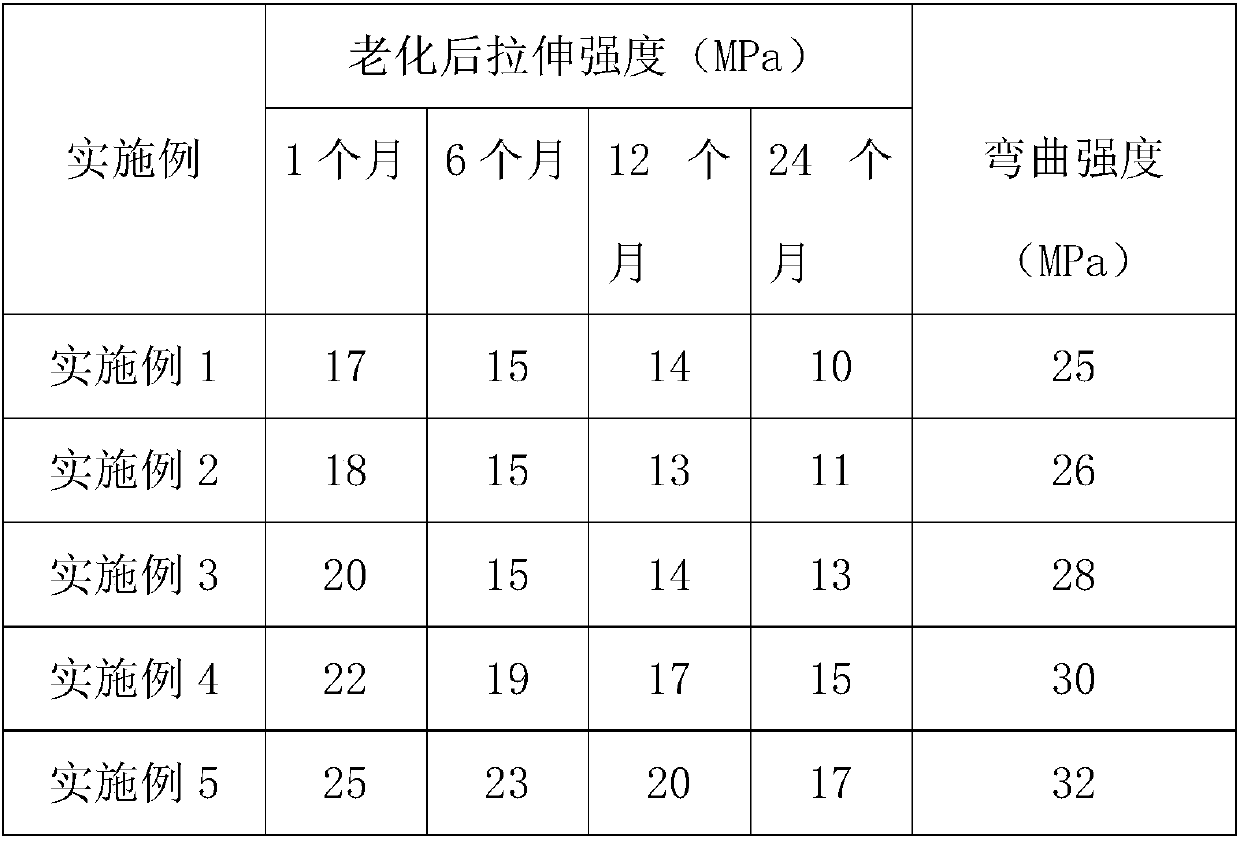Aging-resistant wood-plastic packaging material and preparation method thereof
A packaging material and anti-aging technology, which is applied in the field of wood-plastic packaging materials, can solve the problems of low bonding strength, weak aging resistance, and low affinity, and achieve the effects of improved overall performance, high bonding strength, and improved affinity
- Summary
- Abstract
- Description
- Claims
- Application Information
AI Technical Summary
Problems solved by technology
Method used
Image
Examples
Embodiment 1
[0022] (1) Grind 60 parts of wood fiber to wood powder with a particle size of 80 meshes, add 6 parts of dimethyl sulfate and 20 parts of polyethylene glycol, place in a high-pressure reaction vessel, and react for 40 minutes under a pressure of 4 MPa to obtain a modified wood flour;
[0023] (2) 20 parts of polypropylene particles, 5 parts of basic magnesium sulfate whiskers, 5 parts of cyclophosphamide and 4 parts of p-hydroxypropiophenone were mixed and stirred for 5 minutes; then they were melt blended and granulated through an extruder to obtain modified Polypropylene particles; the extrusion temperature is 160°C, and the screw speed is 30rpm;
[0024] (3) Mix the modified wood powder described in step (1) with the modified polypropylene particles described in step (2), and add 2 parts of azodicarbonamide, 1 part of dicumyl peroxide, 9 parts of 4 -butanediol ester and 15 parts of acrylic acid, stirred and reacted at a temperature of 120° C. for 20 minutes;
[0025] (4) ...
Embodiment 2
[0028] (1) Grind 70 parts of wood fiber to wood powder with a particle size of 120 mesh, add 10 parts of dimethyl sulfate and 30 parts of polyethylene glycol, place in a high-pressure reaction vessel, and react for 30 minutes under a pressure of 8 MPa to obtain a modified wood flour;
[0029] (2) 30 parts of polypropylene particles, 8 parts of basic magnesium sulfate whiskers, 3 parts of cyclophosphamide and 1 part of p-hydroxypropiophenone were mixed and stirred for 10 minutes; then they were melt blended and granulated through an extruder to obtain modified Polypropylene particles; the extrusion temperature is 180°C, and the screw speed is 20rpm;
[0030] (3) Mix the modified wood powder described in step (1) with the modified polypropylene particles described in step (2), and add 4 parts of azodicarbonamide, 3 parts of dicumyl peroxide, 4 parts of 4 -butanediol ester and 20 parts of acrylic acid, stirred and reacted at a temperature of 90° C. for 40 minutes;
[0031] (4) ...
Embodiment 3
[0034] (1) Grinding 62 parts of wood fiber to wood powder with a particle size of 100 meshes, adding 8 parts of dimethyl sulfate and 26 parts of polyethylene glycol, placing them in a high-pressure reaction vessel, and reacting for 35 minutes under a pressure of 6 MPa to obtain a modified wood flour;
[0035] (2) Mix and stir 24 parts of polypropylene particles, 7 parts of basic magnesium sulfate whiskers, 3 parts of cyclophosphamide and 4 parts of p-hydroxypropiophenone for 6 minutes; then melt blend and granulate through an extruder to obtain a modified Polypropylene particles; the extrusion temperature is 168°C, and the screw speed is 22rpm;
[0036] (3) Mix the modified wood powder described in step (1) with the modified polypropylene particles described in step (2), and add 3 parts of azodicarbonamide, 1 part of dicumyl peroxide, 8 parts of 4 -butanediol ester and 17 parts of acrylic acid, stirred and reacted at a temperature of 100° C. for 28 minutes;
[0037] (4) Add ...
PUM
 Login to View More
Login to View More Abstract
Description
Claims
Application Information
 Login to View More
Login to View More - R&D
- Intellectual Property
- Life Sciences
- Materials
- Tech Scout
- Unparalleled Data Quality
- Higher Quality Content
- 60% Fewer Hallucinations
Browse by: Latest US Patents, China's latest patents, Technical Efficacy Thesaurus, Application Domain, Technology Topic, Popular Technical Reports.
© 2025 PatSnap. All rights reserved.Legal|Privacy policy|Modern Slavery Act Transparency Statement|Sitemap|About US| Contact US: help@patsnap.com

